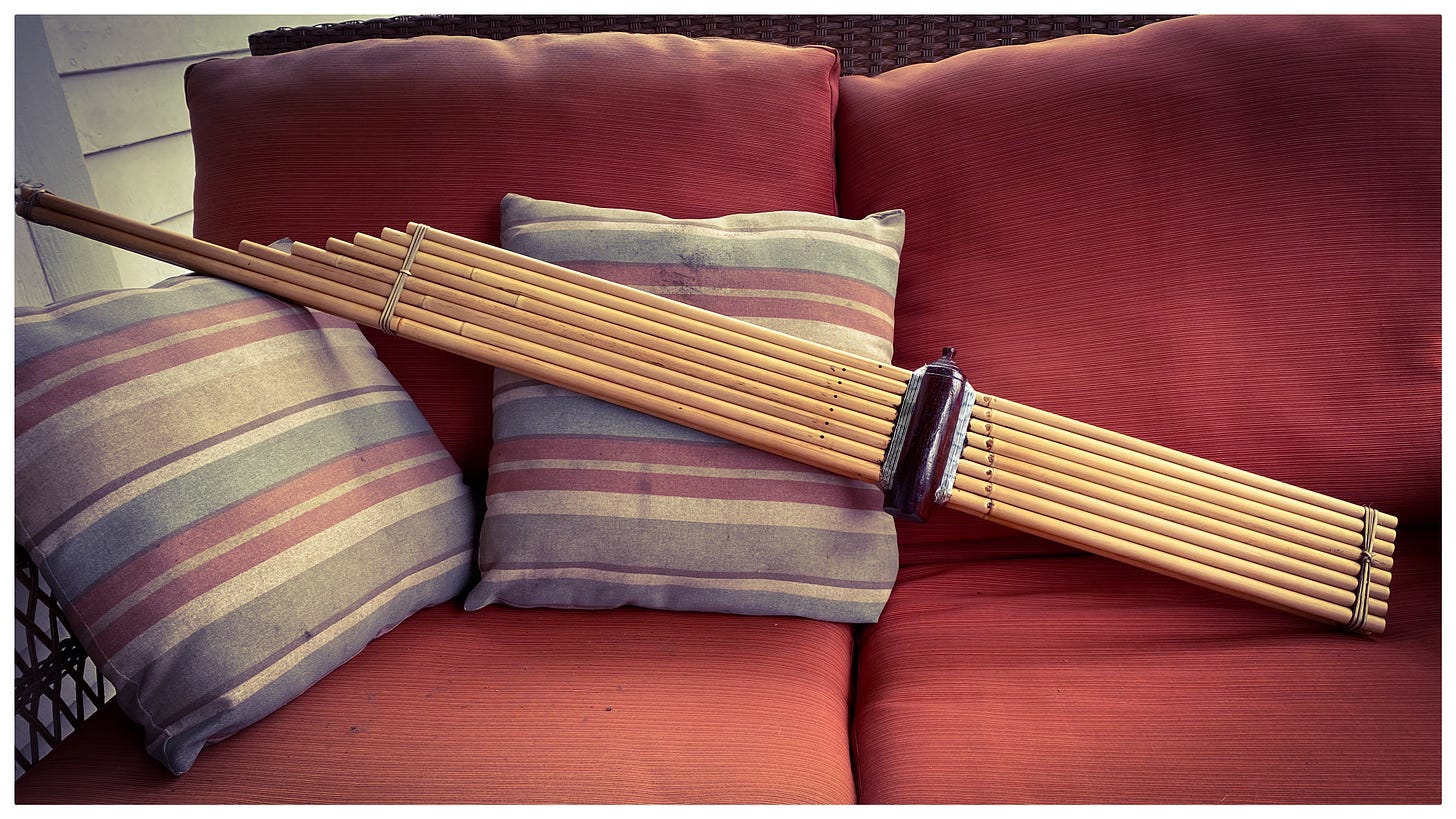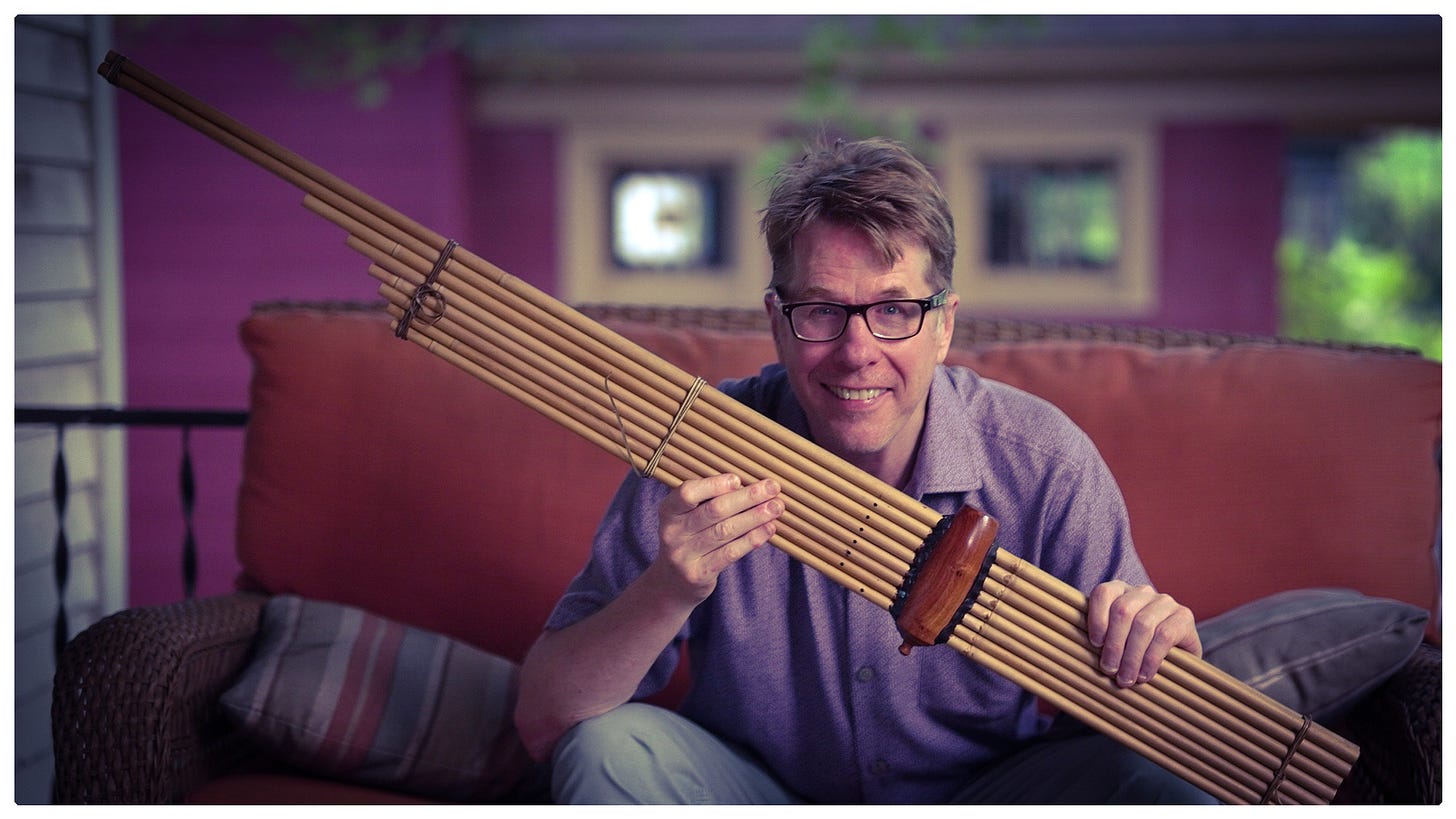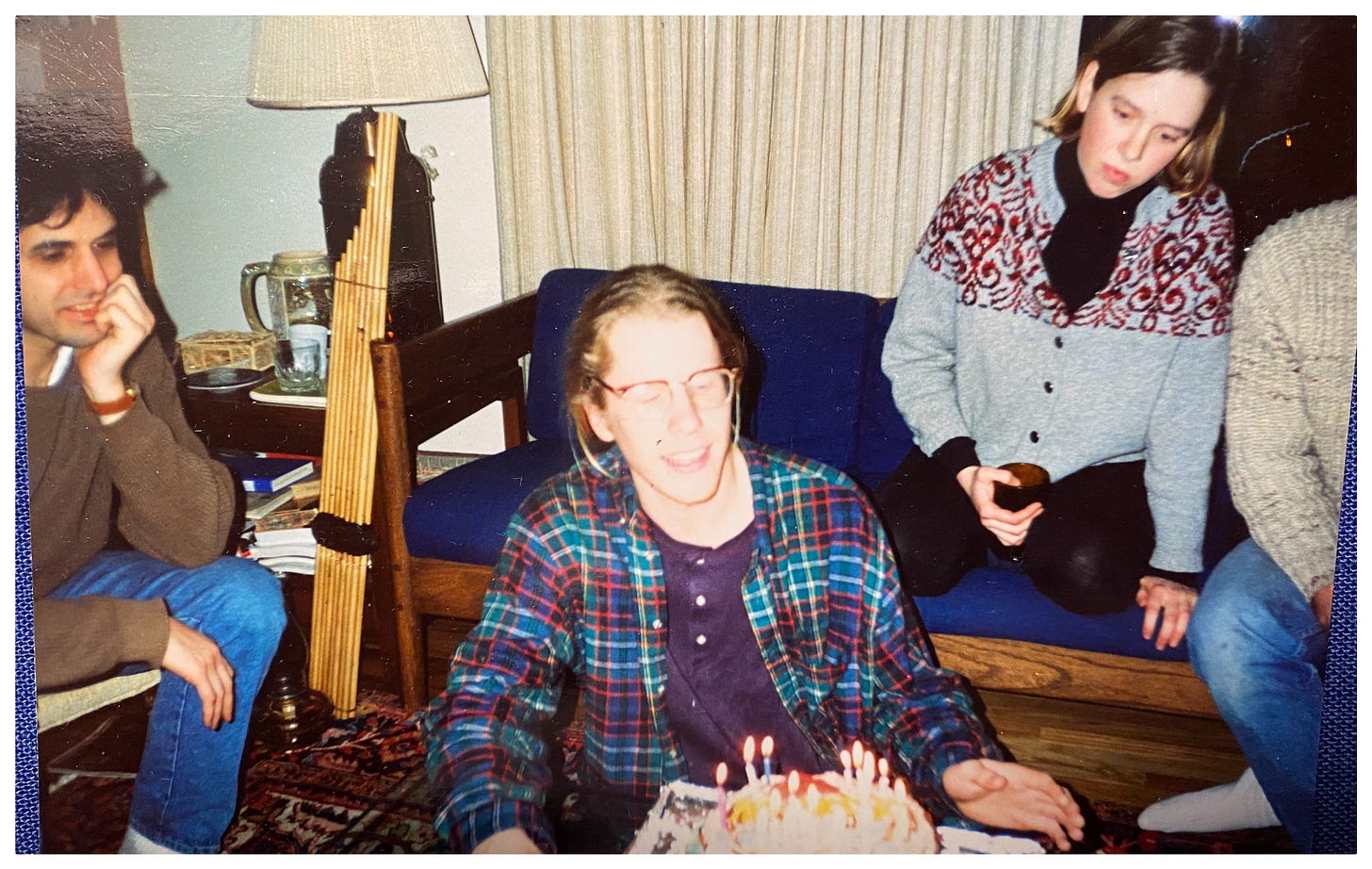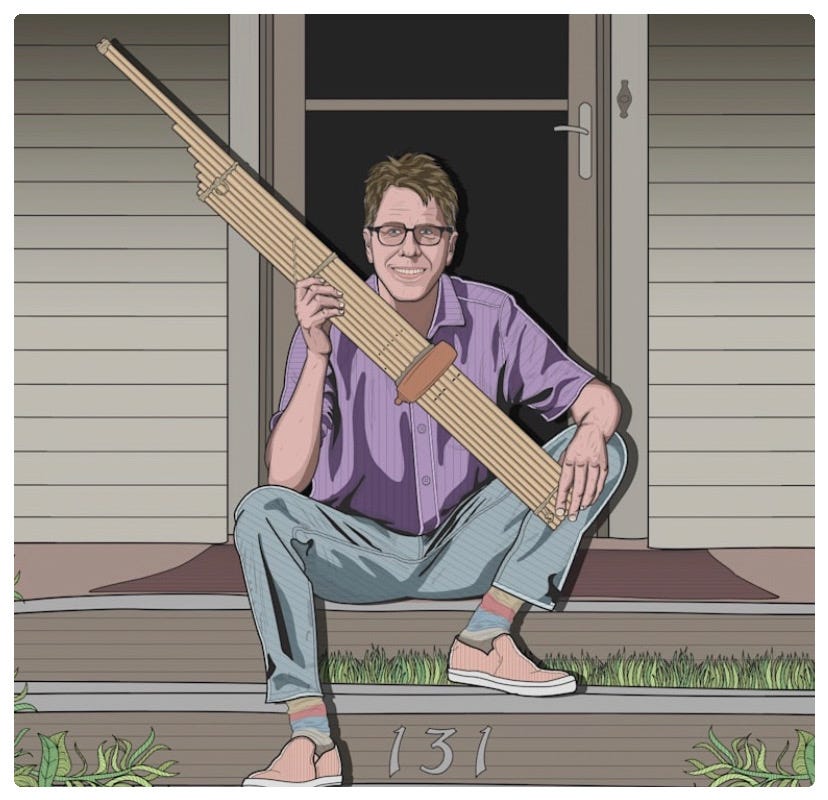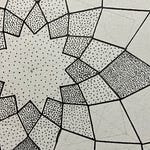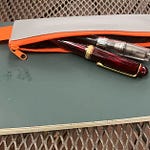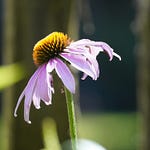Hi. Welcome to Living in a Body. This week, I’m sharing a piece that I wrote a couple months ago. I hope you enjoy. The podcast version includes original music. Please click the play button above. Also, feel free to share. Thanks!
King of the Khaen
Have you ever heard of the melodious khaen? (Pronounced 'can') It's the grandmother of the harmonica. A three foot tall mouth organ made of bamboo pipes and brass reeds, the khaen is the national instrument of Laos. It's part of the "free reed" family of musical instruments. A tiny brass reed is embedded in each bamboo pipe. The reed is free to vibrate on one side and it’s securely attached on the other. The sound that this ancient contraption produces is unexpectedly sublime. Truly, you've got to hear it to believe it. It's a pleasing polyphonic blend of trumpets, harmonicas, and oboes with the baritone drone of the bagpipes mixed in there, too.
Though free reed instruments have been common in East Asia since ancient times, it wasn't until the 18th century that instruments like the khaen from Laos and the sheng from China made their way across Asia to delight western ears. It was the free reed family of the East that inspired the development of the modern day harmonica, the accordion, the concertina and more. If you ask me what my favorite musical instrument is these days, I'm gonna tell you that my E minor khaen sitting in the other room is at the very top of the list.
According to my best recollection, I first touched my lips to the mouth of a khaen in 2004. At that time, my musician friend, David Badagnani was house sitting for Dr. Terry Miller. Dr. Miller is an ethnomusicologist at Kent State University who specializes in the music of northeast Thailand, a region whose music and history is closely associated with Laos. On one summer evening in 2004, I needed some help notating a song, so I paid a visit to David. At some point in our get together, I stood up from the dining room table, moved into the living room and I noticed a musical instrument that I'd never played before. In a room full of musical relics, my eyes were drawn to 16 bamboo pipes strapped together like an organ, like some sort of mouth organ. Being a harmonica player, I picked it up, covered a few random holes and I blew some funky rhythms into the wind chamber. In that moment, my life changed forever. Three years later, I would travel with Dr. Miller to remote villages of northeast Thailand in search of the original harmonica. In these far off places, Dr. Miller would connect me with some of the very finest makers of this traditional musical instrument, the khaen.
In case we're meeting for the first time, my name's Hal Walker. On TikTok, I'm @banakula. Believe it or not, I'm a world famous khaen player. In fact, of all the khaen players in the world, I'm the most famous. Thanks to TikTok and Instagram, I've introduced this instrument to an entire worldwide generation. My audience spans the globe and most of them are under 25 years of age. Most of them have never heard of a little country called Laos or the Isaan territory of Thailand where my E minor khaen was made. As far as my 2.3 million followers are concerned, when it comes to the khaen, I'm the original, the O.G. In TikTok terminology, @banakula is the “king of the khaen.”
Doesn't it just figure that the most famous khaen player in history is a white guy from Ohio? Isn't that just the way the injustice of the world works these days? An impoverished nation like Laos produces a miracle of a mouth organ. The instrument survives through a long history of beauty and struggle. It carries with it a tradition of tunes that were passed down from generation to generation. Then some tall blonde guy from Ohio gets hold of one and plays a couple funky rhythms into it and he gets famous on TikTok. This guy never gets around to learning the traditional tunes, but nonetheless, his modern day melody reaches millions. His beat gets into the hands of a couple hip hop producers and their remixes take on a life of their own. This khaen music becomes one of the most popular trending sounds on the internet. No matter where you go on YouTube, Tik Tok, or Instagram, the sound of "Low Key Gliding" is waiting there for you. The sound has permeated social media culture. While the whole fragile Lao tradition is forgotten along the way, the white guys involved end up making some good money off the whole situation.
In case you didn't catch it, the white guy in the previous paragraph is me, Hal Walker, the guy with ME/CFS that writes “Living in a Body.” The truth is that the majority of my income these days comes from my khaen playing. My song "Low Key Gliding" has three million streams on Spotify, millions of hits on YouTube, and 132 million views on TikTok. It's just two chords played over and over again, but there's a whole generation of young people that absolutely love it. In every little corner of the world, youth are huddled around their phones listening to Hal Walker play his melody on this ancient Lao instrument. This phenomenon makes me a one-hit wonder and the timing couldn't have been more perfect.
In 2021, with the devastating onset of moderately severe ME/CFS, I lost much of my capacity to work as a musician. I'm no longer performing in schools and I recently resigned from 25 years as the music director of the Unitarian-Universalist Church of Kent. But a couple weeks ago, I posted another 30 second rendition of "Low Key Gliding" on Instagram. Today, that video has been viewed over three million times. Now, Instagram will send me a few hundred bucks and the khaen continues it's journey into the hearts of young people all around the world.
Over and over again, I get comments from Lao-Americans thanking me for bringing their national instrument into the limelight. And over and over again, I receive messages from wanna-be khaen players who are dying to know how to get hold of one of these things. Time and time again, I have to explain, "It's very difficult to get a good quality khaen. Have you considered starting with a harmonica? That's what I did." There are just a few khaen makers still living and they reside in remote villages of Northeast Thailand and Laos. It takes days for these craftsmen to make just a single instrument. I have to remind the potential buyers that this is not Amazon we're dealing with here. There's no money back guarantee. However, if the buyer has about five hundred bucks to spend and they're willing to take a risk, I might be able to connect them with a guy. Needless to say, thanks to "Low Key Gliding," the demand for khaens on Amazon is like never before in history.
I'm aware that along with fame and fortune comes responsibility. The fact that I have such a large platform calls me to find ways to use this platform for good. Phrases like "cultural appropriation,", "colonization," and "whitewashing history" linger guiltily in the back of my mind and occasionally show up in my comment section. I'm no expert in the matter, but I've made an effort to educate my audience on the origin of the khaen. The video that's pinned at the top of my TikTok profile says this:
“The instrument that has captured the attention of so many of my TikTok followers is called the khaen. The origin of this instrument is the country of Laos. The maker of the particular instrument that I’m playing is a man named Buavhan. He’s part of the Phuan tribe of the Xiengkhuan province of northeast Laos. It takes him several days just to make one khaen. I have such deep love for this instrument and I’d like somehow to honor and pay tribute to the culture from where it came. Thank you Buavhan. Thank you for the days you spent making this instrument. Thank you Lao people. Thank you for the culture that you created over many generations. Thank you to all of you who have responded so lovingly to the amazing sound of the khaen. I encourage you to search for traditional khaen playing on YouTube and visit my friend Jonny Olsen’s YouTube channel to watch the whole process of making a khaen.”
Currently, I'm struggling with the question of how I can do more. I'd like somehow to lift up the culture and the craftsmanship from whence this instrument comes. I'm interested in find ways to give back to the people of Laos and Northeast Thailand that have given me so much. This is all new thinking to me and I don't know how to sort it all out, but I'm grateful to bring you in on the conversation. I figure if I can just do one little action a month, maybe I can make some kind of difference.
A few weeks ago, I spoke on the telephone with a young khaen player from Nakhon Phanom, Thailand. Aum Suwamat lives right on the Mekong River at the border of Thailand and Laos. We follow each other on Instagram and she's a master of traditional khaen playing. The language barrier between us is severe, but it was a fun conversation. I'm hoping to be a source for Aum to practice her English and I'd love to learn a few Thai phrases myself.
Of course, one of the tragic realities of this whole story is that I’m living with moderately severe ME/CFS. Due to my health, my energy for doing just about anything is severely limited. On a good day, I have just enough strength to play "Low Key Gliding" for about three or four minutes. My lungs are seriously compromised. In some other reality, right now I'd be booking a tour of performances in Southeast Asia. I'd be purchasing my plane tickets, practicing the khaen six hours a day, learning the language and learning the vast repertoire of traditional tunes. Given my limitations, I'm gonna have to find some other way to contribute.
After my conversation with Aum, I was struck with a big idea. As you may know, I have a tendency for big ideas and I’ve got to be careful. Big ideas can be very dangerous for people living with ME/CFS. Even the brain power for editing this episode is taking it’s toll. It's hard enough just keeping up with the most basic tasks of living, much less taking on the injustices of the musical instrument world. But I'm convinced that this idea is a good one. Maybe you'd like to help me make it come true or maybe you'd prefer to help me stay in the reality of living with this illness. Here's what I'm thinking:
Thanks to Dr. Terry Miller, Kent, Ohio is one of the world centers of khaen playing. I may be the only person that recognizes this fact, but it's true. At last count, there are at least four khaen players living here in Kent. I guarantee there's no other town in the US where four experienced khaen players reside. I'd like you and me to host a khaen festival here in Kent, Ohio. Heck, it could even happen in the new social hall of the UU church. The lineup would be incredible. We could find a khaen maker from Laos. Aum Suwamat from Thailand would represent the next generation. Jonny Olsen from Florida, Christopher Adler from Los Angeles and Priwan Nanongkham from Kent would be featured artists. Dr. Terry Miller could give us a lesson in the history of the khaen. And of course, Tik Tok’s king of the khaen would at some point do an epic rendition of "Low Key Gliding." Imagine that: A whole weekend dedicated to the khaen. Hundreds of people could learn the origins of this beautiful instrument and possibly even go home with one themselves. What d'ya say? "Kent Khaen Festival?" Who wants to chair the committee?
A few weeks ago, my mom dug up a photograph of me that has me utterly perplexed. This photo was taken at my parents home at a birthday party in 1991. Incredibly, there's a khaen sitting right behind me in the photo. As far as I know, my first playing of a khaen was in 2003. Almost as if it were photoshopped into the scene, there it is, a khaen. Of course, there must be a reasonable explanation. I imagine that someone at the party was associated with Dr. Miller and brought the khaen over for show-in-tell. But tell me, what are the chances that such a photo would exist, – a photo that would so serendipitously foretell the musical future of the guy sitting there with the birthday cake. Little did we know that that guy blowing out those candles would become the most famous khaen player in the world, the king of the khaen. Little did we know. It’s wild.
Thank you so much for reading. Have a great week and remember to enjoy living in that body of yours today. All the best. Happy New Year! ❤️ Hal
Follow me on Instagram. (210k followers)
Hang out with me on TikTok. (2.3M followers)
Grow with me on YouTube. (60k subscribers)
I haven’t figured out Twitter yet, but I’m there. (354 followers)
I stop by Facebook occasionally. (2.3k followers)
My website is super old but I’m hoping to revamp it soon.
Start your own Substack! I’d be happy to help you get started.



